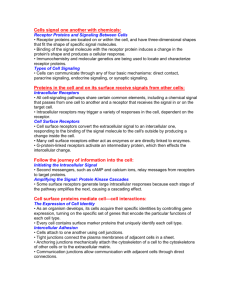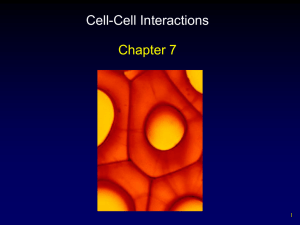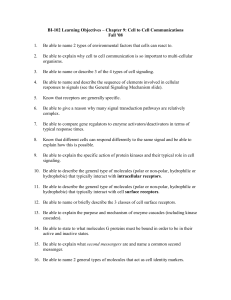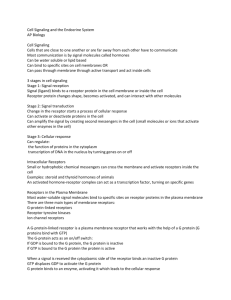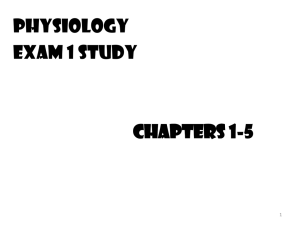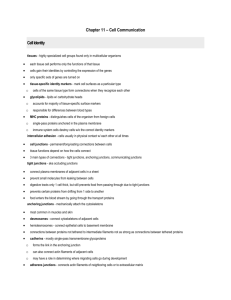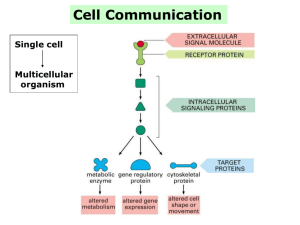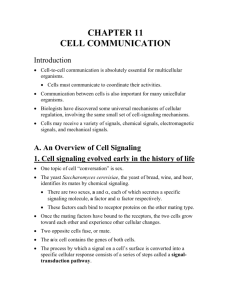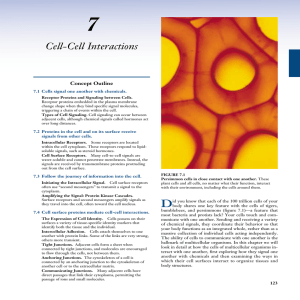Document 8590959
advertisement
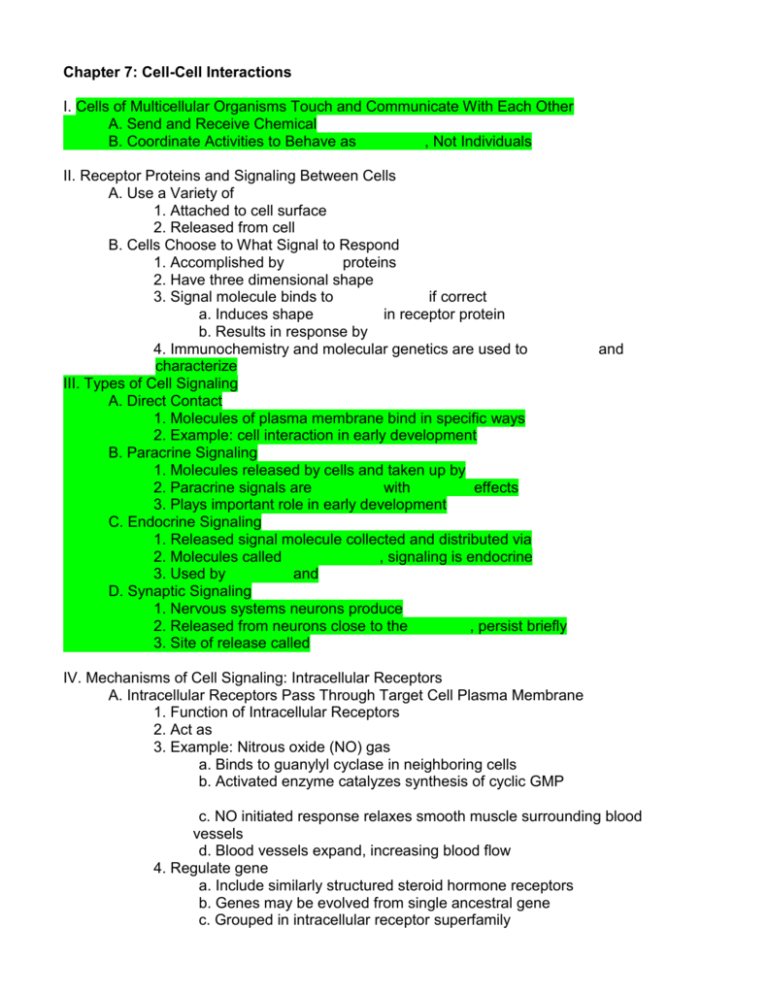
Chapter 7: Cell-Cell Interactions I. Cells of Multicellular Organisms Touch and Communicate With Each Other A. Send and Receive Chemical B. Coordinate Activities to Behave as , Not Individuals II. Receptor Proteins and Signaling Between Cells A. Use a Variety of 1. Attached to cell surface 2. Released from cell B. Cells Choose to What Signal to Respond 1. Accomplished by proteins 2. Have three dimensional shape 3. Signal molecule binds to if correct a. Induces shape in receptor protein b. Results in response by 4. Immunochemistry and molecular genetics are used to characterize III. Types of Cell Signaling A. Direct Contact 1. Molecules of plasma membrane bind in specific ways 2. Example: cell interaction in early development B. Paracrine Signaling 1. Molecules released by cells and taken up by 2. Paracrine signals are with effects 3. Plays important role in early development C. Endocrine Signaling 1. Released signal molecule collected and distributed via 2. Molecules called , signaling is endocrine 3. Used by and D. Synaptic Signaling 1. Nervous systems neurons produce 2. Released from neurons close to the , persist briefly 3. Site of release called and IV. Mechanisms of Cell Signaling: Intracellular Receptors A. Intracellular Receptors Pass Through Target Cell Plasma Membrane 1. Function of Intracellular Receptors 2. Act as 3. Example: Nitrous oxide (NO) gas a. Binds to guanylyl cyclase in neighboring cells b. Activated enzyme catalyzes synthesis of cyclic GMP c. NO initiated response relaxes smooth muscle surrounding blood vessels d. Blood vessels expand, increasing blood flow 4. Regulate gene a. Include similarly structured steroid hormone receptors b. Genes may be evolved from single ancestral gene c. Grouped in intracellular receptor superfamily d. Each receptor has DNA binding site occupied by protein e. Signal molecule binding to another site on receptor releases f. Receptor binds then to DNA to or gene V. Mechanisms of Cell Signaling: Cell Surface Receptors A. Cell Surface Receptors Cannot Diffuse Through Cell Membranes 1. Signals bind to proteins on cell 2. Convert extracellular signal to intracellular signal 3. Produces change in cell's 4. Include three superfamilies B. Chemically Gated Ion Channels 1. Receptor is multi-pass 2. Winds across plasma membrane several times 3. Center of protein forms a through which can pass 4. Ion channel or when neurotransmitter binds to protein, called 5. Type of ion determined by of ion channel C. Enzymatic Receptors 1. Acts as or are directly linked to 2. between signal molecule and receptor activates the enzyme 3. Most are protein kinases, add groups to proteins a. Single pass transmembrane protein b. Signal molecule binds outside cell c. Portion initiating enzyme activity is in cell's cytoplasm D. G Protein-Linked Receptors 1. GTP binding G protein assists or 2. Largest superfamily composed of seven-pass transmembrane protein fig 3. Signal binding causes G protein to bind and become a. Activated protein diffuses away from receptor to begin actions b. involved in mechanism of half of currently in use VI. Initiating the Intracellular Signal A. Second Messengers Relay Message, also called B. Small molecules or ions that change shape and behavior of receptor proteins C. cAMP 1. Used as second messenger by all known 2. Example: adrenaline binding to beta-adrenergic receptor (G protein-linked) a. Binding adrenaline activates G protein b. Enzyme adenylyl cyclase produces large amounts of cAMP in target cell c. cAMP binds to A-kinase d. Activates it to phosphorylate cell proteins e. Action dependent on cell type, in muscle stimulates glycogen to D. Calcium 1. Chemically-gated calcium channels in membrane 2. Influx of Ca++ from inside ER to cytoplasm triggers many activities 3. Skeletal muscles , some endocrine cells release 4. Receptor activates G protein which activates phospholipase C enzyme 5. Phospholipase C catalyzes production of inositol triphosphate (IP3) 6. IP3 binds to Ca++ channels them 7. Also initiates response by binding to calmodulin VII. Cell-Cell Interactions and the Expression of Cell Identity A. Tissues Are a Fundamental Property of Multicellular Organisms 1. All cells within a tissue are identified as members of that tissue 2. Identification results from the presence of unique B. Cell Surface Markers 1. Some are , lipids with carbohydrate tails 2. Differentiate and within the vertebrate body 3. Markers on surface of red blood cells identify blood types 4. Cell populations of glycolipids change as cells differentiate 5. Some are proteins anchored in the plasma membrane 6. Immune system marker proteins 7. Major histocompatibility complex (MHC) proteins VIII. Intercellular Adhesion A. Cell Junctions Are Long-Lasting Physical Connections Between Cells B. Nature of the connection determines what tissue is like C. Tissue function dependent on how individual cells arranged within it D. Tight Junctions 1. Connect adjacent cells to prevent small molecules from leaking 2. Cells act as wall within an organ 3. Molecules sequestered within a region a. Example: cells lining digestive tract b. Partition plasma membranes of lining cells together c. Nutrient transport proteins must stay in proper orientation to function E. Anchoring Junctions 1. Common in sheets of tissues exposed to 2. Cadherin protein junctions a. Attach cell cytoskeleton to other cells or extracellular matrix b. Desmosomes: connect of adjacent cells c. : anchor epilthelial cells to basement membrane d. Single-pass transmembrane glycoproteins e. Cytoplasmic end linked to intermediate filaments f. Other end projects through membrane links to cadherin of next cell g. More than connection to free-floating membrane proteins h. Cadherins also connect to cell's actin framework, less stable connection 3. Adherens junctions a. Connect actin filaments of neighboring cells or extracellular matrix b. Linking proteins belong to superfamily of receptors called c. Integrin is transmembrane protein made of two glycoprotein subunits F. Communicating Junctions 1. or small molecules from one cell to another 2. Example: chemical synapses passing 3. Example: gap junctions 4. Composed of connexons a. Six identical transmembrane proteins arranged in a circle b. Connexons of two adjacent cells must be perfectly aligned c. Small molecules like and can pass d. Are dynamic structures that can and e. Respond to factors like and ions f. If cell damaged ions flow , close gap junctions, 5. In plants, provide cytoplasmic connections between cells a. Occur only at in cell walls b. Function like animal cell junctions c. Are lined with d. Contain central tubule connecting of both cells G. Summary of Cell Communication Mechanisms cell
